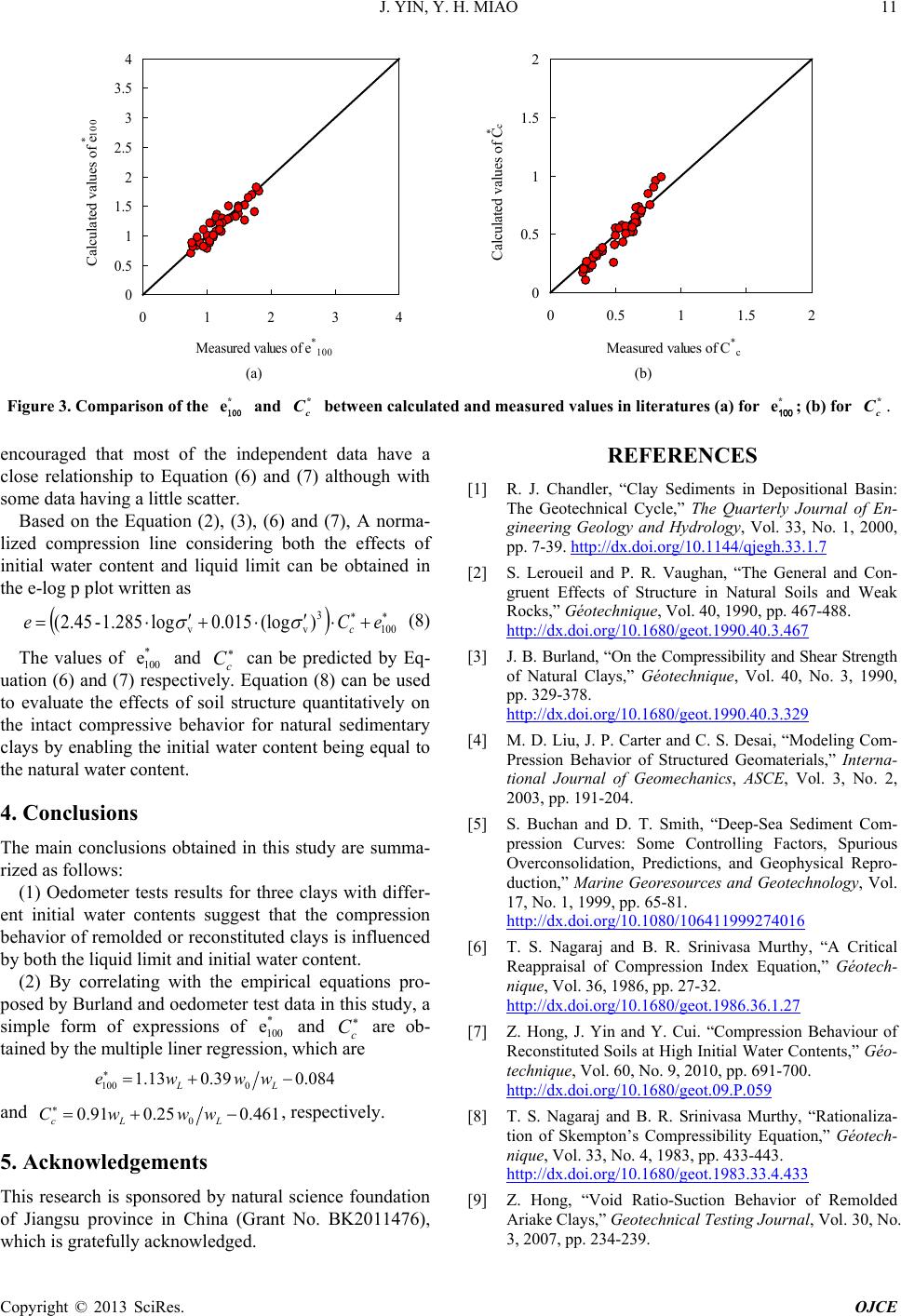
J. YIN, Y. H. MIAO
Copyright © 2013 SciRes. OJCE
Calculated values of e
*100
(a) (b)
Figure 3. Comparison of the *
e
and
between calculated and measured values in literatures (a) for *
e
; (b) for
.
encouraged that most of the independent data have a
close relationship to Equation (6) and (7) although with
some data having a little scatter.
Based on the Equation (2), (3), (6) and (7), A norma-
lized compression line considering both the effects of
initial water content and liquid limit can be obtained in
the e-log p plot written as
( )
∗∗
+⋅
′
⋅+
′
⋅=
100
3
vv
)(log0.015log1.285-2.45(eCe
c
σσ
(8)
The values of *
100
e and
can be predicted by Eq-
uation (6) and (7) respectively. Equation (8) can be used
to evaluate the effects of soil structure quantitatively on
the intact compressive behavior for natural sedimentary
clays by enabling the initial water content being equal to
the natural water content.
4. Conclusions
The main conclusions obtained in this study are summa-
rized as follows:
(1) Oedometer tests results for three clays with differ-
ent initial water contents suggest that the compression
behavior of remolded or reconstituted clays is influenced
by both the liquid limit and initial water content.
(2) By correlating with the empirical equations pro-
posed by Burland and oedometer test data in this study, a
simple form of expressions of
and
are ob-
tained by the multiple liner regression, which are
084.039.013.1
0100
−+=
∗LL
wwwe
and
461.025.091.0
0
−+=
∗LLc
wwwC
, respectively.
5. Acknowledgements
This research is sponsored by natural science foundation
of Jiangsu province in China (Grant No. BK2011476),
which is gratefully acknowledged.
REFERENCES
[1] R. J. Chandler, “Clay Sediments in Depositional Basin:
The Geotechnical Cycle,” The Quarterly Journal of En-
gineering Geology and Hydrology, Vol. 33, No. 1, 2000,
pp. 7-39. http://dx.doi.org/10.1144/qjegh.33.1.7
[2] S. Leroueil and P. R. Vaughan, “The General and Con-
gruent Effects of Structure in Natural Soils and Weak
Rocks,” Géotechnique, Vol. 40, 1990, pp. 467-488.
http://dx.doi.org/10.1680/geot.1990.40.3.467
[3] J. B. Burland, “On the Compressibility and Shear Strength
of Natural Clays,” Gé otechnique, Vol. 40, No. 3, 1990,
pp. 329-378.
http://dx.doi.org/10.1680/geot.1990.40.3.329
[4] M. D. Liu, J. P. Carter and C. S. Desai, “Modeling Com-
Pression Behavior of Structured Geomaterials,” Interna-
tional Journal of Geomechanics, ASCE, Vol. 3, No. 2,
2003, pp. 191-204.
[5] S. Buchan and D. T. Smith, “Deep-Sea Sediment Com-
pression Curves: Some Controlling Factors, Spurious
Overconsolidation, Predictions, and Geophysical Repro-
duction,” Marine Georesources and Geotechnology, Vol.
17, No. 1, 1999, pp. 65-81.
http://dx.doi.org/10.1080/106411999274016
[6] T. S. Nagaraj and B. R. Srinivasa Murthy, “A Critical
Reappraisal of Compression Index Equation,” Géotech-
nique, Vol. 36, 1986, pp. 27-32.
http://dx.doi.org/10.1680/geot.1986.36.1.27
[7] Z. Hong, J. Yin and Y. Cui. “Compression Behaviour of
Reconstituted Soils at High Initial Water Contents,” Géo-
technique, Vol. 60, No. 9, 2010, pp. 691-700.
http://dx.doi.org/10.1680/geot.09.P.059
[8] T. S. Nagaraj and B. R. Srinivasa Murthy, “Rationaliza-
tion of Skempton’s Compressibility Equation,” Géotech-
nique, Vol. 33, No. 4, 1983, pp. 433-443.
http://dx.doi.org/10.1680/geot.1983.33.4.433
[9] Z. Hong, “Void Ratio-Suction Behavior of Remolded
Ariake Clays,” Geotechnical Testing Journal, Vol. 30, No.
3, 2007, pp. 234-239.